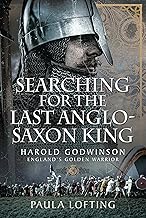 Welcome to England’s Golden Warrior – an interview with Paula Lofting on Harold Godwinson here at Writing with Labradors.
Welcome to England’s Golden Warrior – an interview with Paula Lofting on Harold Godwinson here at Writing with Labradors.
Today I’m delighted to welcome Paula Lofting. Paula has been a guest before, talking about Sons of the Wolf, her series of novels set in the years leading up to the Norman Conquest. She’s here today wearing a different hat, however; she’s just published her first historical biography. Paula, congratulations.
Thank you, Lynn. I am amazed I survived. It was a long hard slog, but I got there in the end.
I’m impressed you made it. Paula your book is called Searching for the Last Anglo-Saxon King: Harold Godwinson – England’s Golden Warrior. This is your first non-fiction book, and it feels to me as though you didn’t choose an easy subject to start with. What made you want to write about Harold?
I have to admit, I thought it was going to be a much easier job than it was. Having been writing the novels in which Harold is a secondary but important character, I thought I had all the research under my belt already. But I found myself looking into things more deeply, and it was a surprise to me that I didn’t know everything after all!
I had chosen to write about Edmund Ironside first, but then I decided actually, why not write a new bio about Harold Godwinson, especially as most of the most well known books about Harold had already been published and needed refreshing. I thought I could do him justice and so when I embarked on the project, I found that what was most important to me was to ‘find’ the real essence of Harold with the scant information we have. Who he was, how his background shaped him, what were the influences that formulated his decision-making. What others thought of him, and how he came to be demonised.
I guess I could qualify for historian status but as a novelist, I’m more emotionally invested in characters and that is why I don’t hold back in giving my opinions in a less objective manner that perhaps an academic would.
I think that’s one of the things about the book that I enjoyed. While you clearly looked at a variety of different opinions, it was obvious that you’re a bit of a fan of Harold. Paula, one of the reasons I said you chose a challenging subject was that there aren’t that many sources, surely? How difficult was the research on this book?
You could say that the fewer sources to read the easier, but it also gives you less scope. I would say that someone who writes about the Peninsular War needs to cover a lot of information and the need to find every little bit of it is far more stressful than the issues I had. I count myself lucky in that respect.
I think the hardest part is sifting through the later sources and the tendency for writers of that time to embellish and fictionalise. Its difficult to take writers like Henry of Huntingdon and William of Malmsbury seriously.
I suppose you have to look at them critically and work out what snippets of truth you can find in the midst of the story telling. I’ve read the book and thoroughly enjoyed it – my review is here if anybody wants to read it. The various sources paint very different pictures of Harold Godwinson, depending on where they came from and when they were writing. Was it difficult to build up a coherent picture of the man?
I would say not, though the Victorians probably had less information to go on than we have now. Once you realise what was propaganda and what was not, I think it is easier. For one thing most of the Norman chronicles after 1066 were fictionalised to make William of Normandy look like an angel and Harold as Satan but they don’t produce solid evidence to back it up. A lot of it is unquantified name calling. Even the famous Papal Banner turned out to be fictionalised, though that took decades and decades to conclude.
As for Harold’s character, if you study his actions in the context of the 11th century environment and the factors surrounding the events of the time, you will find a Harold of some sort in there. That’s why I try to give options for the reader so they can work it out for themselves. Not everyone will agree with me, but that’s ok. As long as most of the possibilities are presented.
One of the things I enjoyed about this book was some of the myth-busting. The last time I learned about the Norman Conquest was during the first year of secondary school which is history in its own right. I didn’t realise how much work had been done since then. Was it scary moving from fiction to historical biography? I’ve never had the nerve to try it myself. In what ways was it different?
Completely different. For a start you have to be more objective and less subjective, and present evidence and facts rather than a story that you make up as you go alone. Then there’s the ‘notes’ you have to make to back up your narrative and the indexing! Whilst I try to inject humour and a little irony into it, there is no dialogue or made up stuff, though there is conjecture aplenty, it’s all based on the evidence written in the sources which can come from a range of areas. Archaeological, written, or illuminated manuscripts.
I could sort of imagine doing it for my own Napoleonic period, just about, because I understand the sources available. I think going back this far must be more challenging. And in fiction, nobody expects footnotes or an index, thank goodness. Harold is a recurring character in your novels as well. Was it difficult to separate out your fictional Harold from the real man you’ve written about in this book?
Not really. I try to portray him realistically in my novels. He’s not your perfect hero who rescues women from their vicious husbands (though there is a myth that said he rescued his second wife from hers) and often makes decisions that badly affects my MC, Wulfhere, which leads Wulfhere to hate him at times. His decision to back the northern rebels instead of his brother Tostig would have displeased many, as it must have done the king. Sometimes he was backed into corners, and it appears that he did what he believed to be right at the time. I think I have portrayed him fairly, according to his deeds and the circumstances he found himself in.
Yes, he comes across as very human. I want to ask about your writing style. One of the things I like about this book is despite the huge amount of research you’ve obviously done, it’s not heavy to read. You’ve kept a light storytelling tone. Was that deliberate or does it just come naturally because of the fiction writing?
It is deliberate, I think. I don’t want my readers to get the idea that I think they are stupid, I just believe in making reading enjoyable and if a text is too difficult or highbrow to read, then I am not achieving this. That’s the beauty of popular history, most writers tend to use easy to understand terms and paint a picture of a landscape inside the readers head of what happened, when, how, and why. I think that it what most people want. But as my dear mentor Sharon Bennett Connolly showed me, you want to be taken seriously too, so there has to be a balance.
As I said before, I really liked the balance you achieved in the end. I don’t know how much of a struggle it was, but it comes across as a really good read but definitely not an Idiot’s Guide to Harold Godwinson. There’s a lot of scholarship tucked away in there. How long did it take you to write this book, including research?
A lot longer than I’d hoped. 2 years I would say.
I think two years is pretty impressive for a project like this to be honest. I wonder how much of that was actual writing and how much was research, indexing and notes? There’s a big cast of characters in a biography like this. Do you have any favourite secondary characters? Maybe someone you’d like to follow up either with another biography or in fiction?
I think I know who you would like to hear more about and as I don’t want to disappoint you, I’ll say Swegn Godwinson. What a character! Swegn was the black sheep of the family. He was a troubled soul and could not get anything right and I have a penchant for bad boys, so I have a soft spot for him as a historical character. There were so many things he did that were just wrong, but in the end, he tried to atone for everything and that is what endears him to me. Sadly, it cost him his life. Such a sad tragic ending. But I shan’t give it away.
I also have a soft spot for the Mercian brothers, the young earls of the North. They were referred to as boys of noble stock which is why I think they were in their teens when they became earls in their own right. They fought a hard battle at Fulford Bridge and despite losing the battle, which was against the Mighty Harald Hardrada, they were said to have fought bravely. Both boys went on to survive the 1066 Conquest and were held as hostages by William. They were given their freedom, but William did not come through with their promises that he’d made to them, good marriages and their own earldoms were given to William’s mates, so they rebelled and got involved with Hereward the Wake’s uprising. In the end, eventually, Edwin died, and Morcar submitted to William and led a comfortable rest of his life as a hostage of William’s.
You’re right, I do love the story of Swegn even though he must have been an absolute nightmare for his family to deal with. There’s probably not enough information out there for a full-blown biography of him, but I wonder if we’ll be seeing something more of him in an article one day, or perhaps a blog post? Or even in fiction. Now I know this can be a difficult question for a biographer but at the end of it, did you like Harold? Did what you learned along the way make you admire him more or less?
I guess I’ve always had a soft spot for Harold since I started reading about the era about 20 years ago, however, I really did think doing all this research would lose me that rose-coloured tinted glasses because when you go as deep as you possibly can, you tend to see the ‘real’ person more and you find out that perhaps they are not as squeaky clean as you think they are. But in Harold’s case, despite the more unsavoury things he did that I never really thought philosophically about until now, I can’t say that I like him less for it because you cannot judge a medieval king with 21st century morals. In fact, it gave me the confidence to actually say that when you compare him to many of the other medieval leaders, he was pretty much one of the good guys. I have come to see that despite being ambitious, I do really believe that he cared considerably for his England and her people. He fought desperately and bravely for his life, and to save his country. He had seen what kind of a man William was and certainly did not wish that on his people. Sadly, he failed.
What was Harold’s best quality and what was his worst?
His best quality was his use of diplomacy rather than going all guns blazing. He was patient with the Welsh until one day they pushed too far, and his patience ran out. He invaded with the help of his brother Tostig, and the power of Wales was diminished. You might say that he was patient to a point and once he snapped, everyone needed to look out.
So his best quality was his patience and his worst was what happened when he lost it? That makes a lot of sense. Paula, you’re probably aware of the new drama series coming out soon about William of Normandy and Harold Godwinson? Will you be watching it or do you think you’ll end up correcting the history too much?
I’m going to try and watch it. I’ll have to find a way around it because I don’t have a TV licence!
And after people have watched the series, your advice is to immediately buy your book I imagine?
Most certainly!
You heard it here first, people. Final question, Paula. What’s next? I know those of us who have read the first two books in your Sons of the Wolf series have been waiting for the further adventures of Wulfhere. Or are there more historical biographies in the future?
I do have the Edmund II book to complete, however I’m hoping to make sure I get my third novel in the Sons of the wolf series finished, Wolf’s Bane. Wulfhere and his lot are getting up to too much mischief!
I’m very much looking forward to that. I suspect you’ll have a much clearer picture of Harold when he wanders into the pages of your novels in the future. And after reading your book, I think I will too.
Paula, thanks so much for coming along to talk to us today. Good luck with the book, you deserve to do well, and perhaps you’ll come back to tell us about your next project when it’s ready to go.
I certainly will. I’ve really enjoyed being on here with you!
My thanks to Paula Lofting for joining me to talk about her new biography of Harold Godwinson.
About the Author
 Paula was born in the ancient Saxon county of Middlesex in 1961. She grew up in Australia hearing stories from her dad of her homeland and its history. As a youngster she read books by Rosemary Sutcliff and Leon Garfield and her love of English history grew. At 16 her family decided to travel back to England and resettle. She was able to visit the places she’d dreamt about as a child, bringing the stories of her childhood to life. It wasn’t until later in life that Paula realised her dream to write and publish her own books. Her debut historical novel Sons of the Wolf was first published in 2012 and then revised and republished in 2016 along with the sequel, The Wolf Banner, in 2017. The third in the series, Wolf’s Bane, will be ready for publishing later this year.
Paula was born in the ancient Saxon county of Middlesex in 1961. She grew up in Australia hearing stories from her dad of her homeland and its history. As a youngster she read books by Rosemary Sutcliff and Leon Garfield and her love of English history grew. At 16 her family decided to travel back to England and resettle. She was able to visit the places she’d dreamt about as a child, bringing the stories of her childhood to life. It wasn’t until later in life that Paula realised her dream to write and publish her own books. Her debut historical novel Sons of the Wolf was first published in 2012 and then revised and republished in 2016 along with the sequel, The Wolf Banner, in 2017. The third in the series, Wolf’s Bane, will be ready for publishing later this year.
In this midst of all this, Paula acquired contracts for nonfiction books with the prestigious Pen & Sword publishers. Searching for the Last Anglo-Saxon King, Harold Godwinson, England’s golden Warrior is now available to buy in all good book outlets, and she is now working on the next non-fiction book about King Edmund Ironside. She has also written a short essay about Edmund for Iain Dale’s Kings and Queens, articles for historical magazines. When she is not writing, she is a psychiatric nurse, mother of three grown up kids and grandmother of two and also re-enacts the Anglo-Saxon/Viking period with the awesome Regia Anglorum.
You can find Paula on the following social media sites:
https://www.instagram.com/paulaloftingwilcox/
https://www.facebook.com/Wulfsuna?locale=en_GB
https://www.threads.net/@paulaloftingwilcox?xmt=AQGzt4dBTQyhpi3KALo3S2LlPFu675xU76a9176zAtMjRdA
https://bsky.app/profile/paulaloftingauthor.bsky.social
Paula’s books are available on the following links.
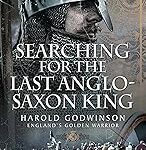 https://mybook.to/Haroldpreorder
https://mybook.to/Haroldpreorder

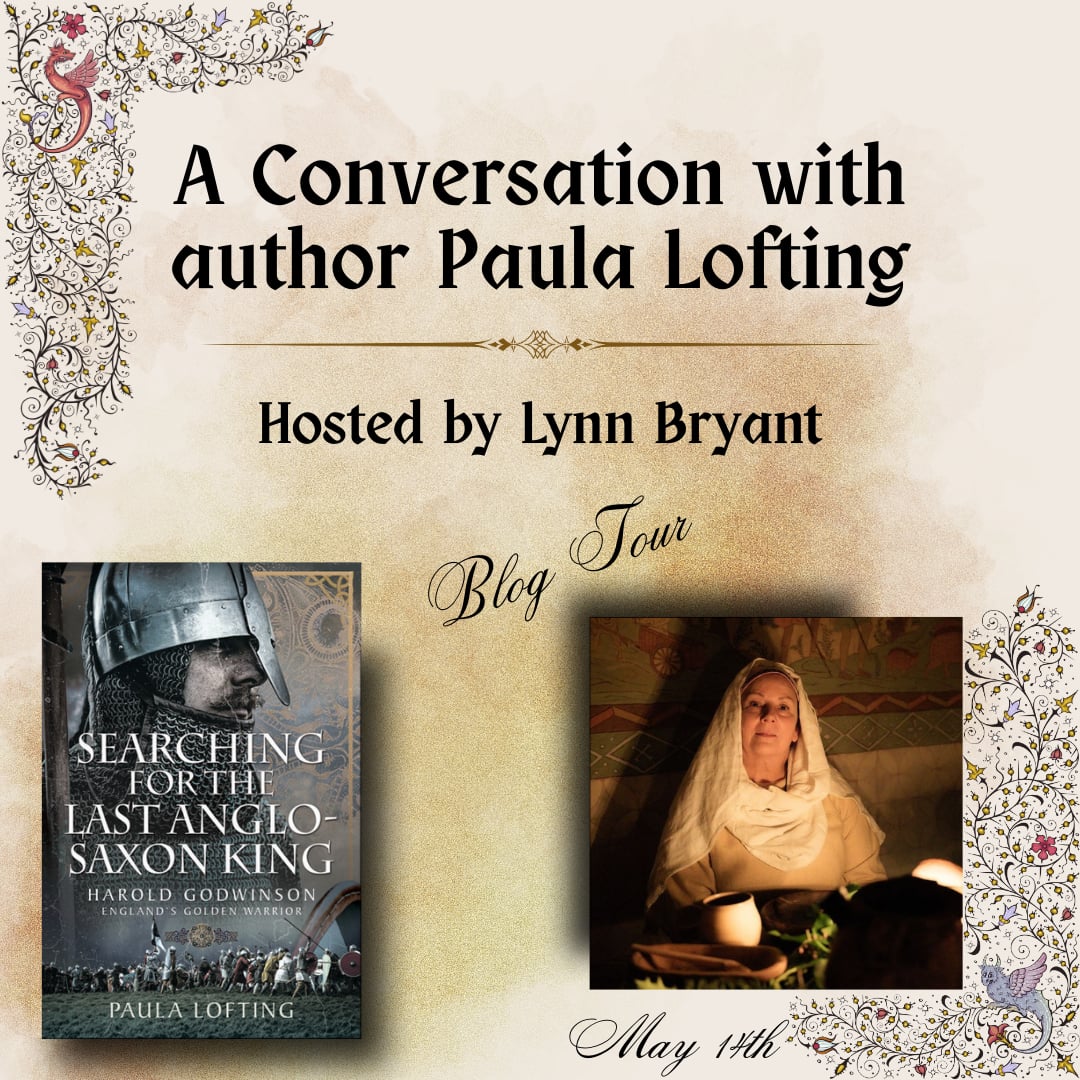
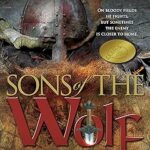
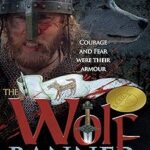
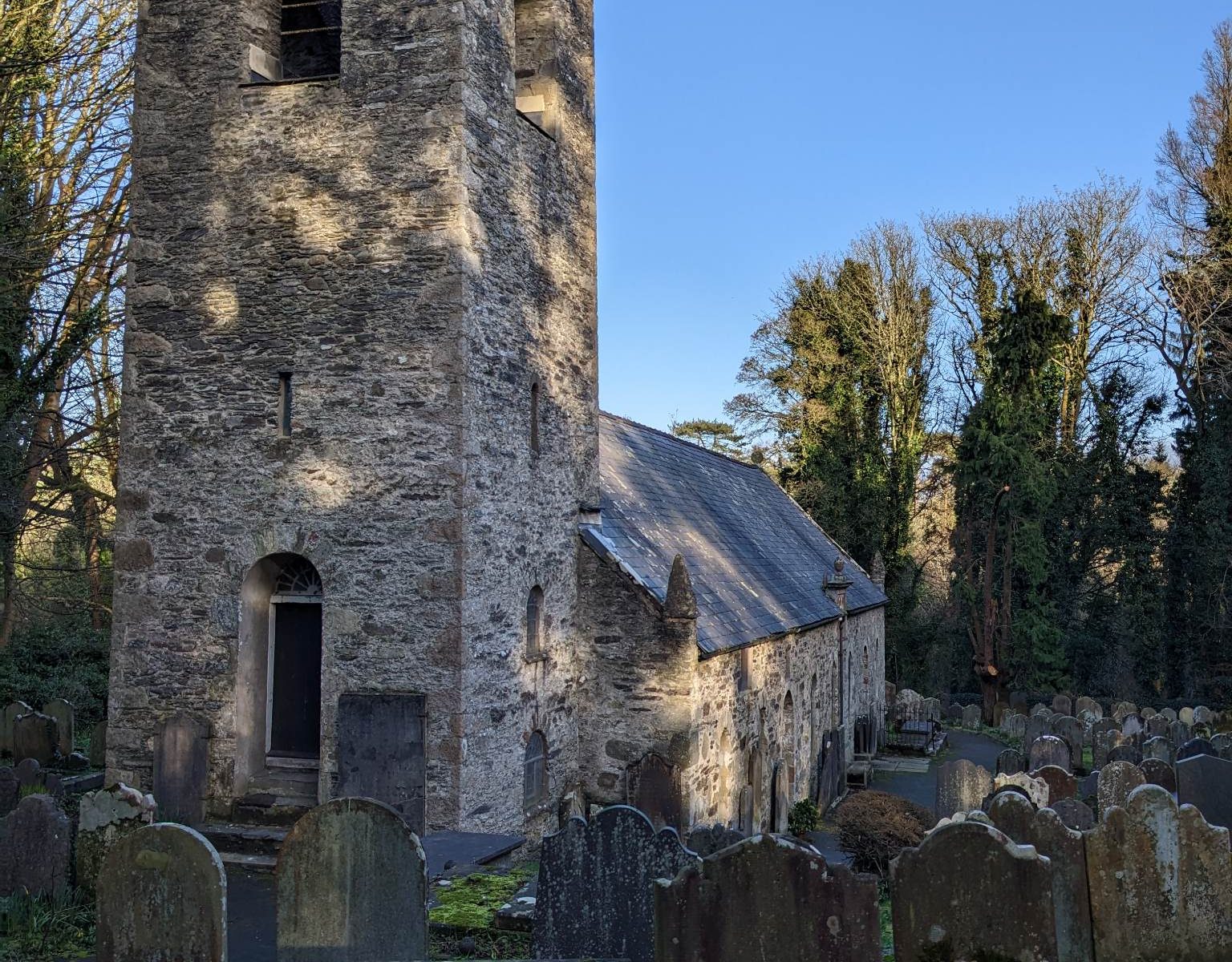
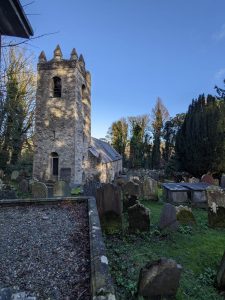 Old Kirk Braddan Church and Cemetery
Old Kirk Braddan Church and Cemetery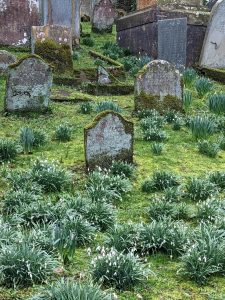 I found myself at Old Kirk Braddan earlier this week when I had an hour to kill before meeting my
I found myself at Old Kirk Braddan earlier this week when I had an hour to kill before meeting my 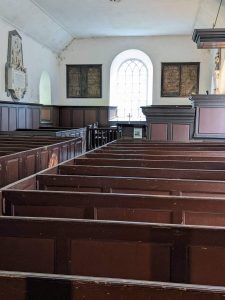 There has been some form of religious worship on this site for fourteen centuries and stones from the first Celtic Keeill (Chapel) can be dated back to around 400 AD. Old Kirk Braddan was rebuilt on the site of an older church in 1777 and is dedicated to Saint Brendan or Braddan. Unlike many other eighteenth century churches, it was never updated during the Victorian era and retains its original box pews, gallery and a three decker pulpit, with a lectern, minister’s pew and pulpit above. It remained the parish church until 1876 when it was replaced by the new church.
There has been some form of religious worship on this site for fourteen centuries and stones from the first Celtic Keeill (Chapel) can be dated back to around 400 AD. Old Kirk Braddan was rebuilt on the site of an older church in 1777 and is dedicated to Saint Brendan or Braddan. Unlike many other eighteenth century churches, it was never updated during the Victorian era and retains its original box pews, gallery and a three decker pulpit, with a lectern, minister’s pew and pulpit above. It remained the parish church until 1876 when it was replaced by the new church.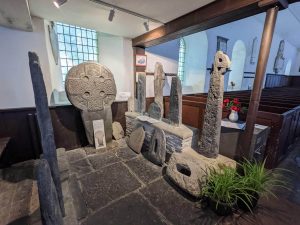 The church contains a number of Celtic and Norse crosses from the period 800-1265, which were found around the parish. Several of these bear a ring chain design which is associated with the sculptor, Gaut, son of Bjorn, who came from the island of Coll in the Hebrides and settled on the Isle of Man. Gaut is considered one of the best carvers of his time which was between 950 and 1040 AD. One of the crosses bearing his designs has been translated as “Gaut created this and all in Mann”. His carvings are of a style seen in many Celtic and later Scandinavian crosses.
The church contains a number of Celtic and Norse crosses from the period 800-1265, which were found around the parish. Several of these bear a ring chain design which is associated with the sculptor, Gaut, son of Bjorn, who came from the island of Coll in the Hebrides and settled on the Isle of Man. Gaut is considered one of the best carvers of his time which was between 950 and 1040 AD. One of the crosses bearing his designs has been translated as “Gaut created this and all in Mann”. His carvings are of a style seen in many Celtic and later Scandinavian crosses.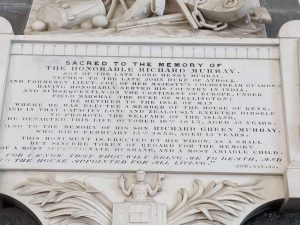 Beyond the Manx crosses, towards the altar, there’s an impressive memorial up on the wall, looking surprisingly elaborate for such a simple church.
Beyond the Manx crosses, towards the altar, there’s an impressive memorial up on the wall, looking surprisingly elaborate for such a simple church.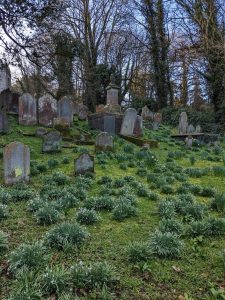 I was aware of another memorial in the churchyard which is known locally as the Atholl monument. Since Murray was the name of the local Dukes of Atholl I went scrambling around among the overgrown graves. It took some time because the place is beautiful; a tangle of greenery dotted with moss covered stones. This is no modern, neatly laid out graveyard, but a piece of history. Many of the graves are sadly difficult to read but one or two are clear enough to give an indication of the long history of Kirk Braddan.
I was aware of another memorial in the churchyard which is known locally as the Atholl monument. Since Murray was the name of the local Dukes of Atholl I went scrambling around among the overgrown graves. It took some time because the place is beautiful; a tangle of greenery dotted with moss covered stones. This is no modern, neatly laid out graveyard, but a piece of history. Many of the graves are sadly difficult to read but one or two are clear enough to give an indication of the long history of Kirk Braddan. 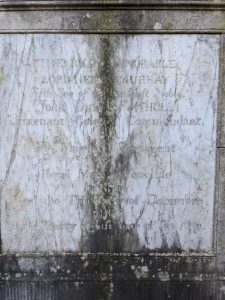 The Atholl monument turned out to be a large obelisk in the centre of the churchyard in honour of Lord Henry Murray, fourth son of John 3rd Duke of Atholl who was born in 1767 and died in the December of 1805. Lord Henry was the Lieutenant-Colone Commandant of His Majesty’s Regiment of Royal Manx Fencibles.
The Atholl monument turned out to be a large obelisk in the centre of the churchyard in honour of Lord Henry Murray, fourth son of John 3rd Duke of Atholl who was born in 1767 and died in the December of 1805. Lord Henry was the Lieutenant-Colone Commandant of His Majesty’s Regiment of Royal Manx Fencibles. In book eight of the Peninsular War Saga which I’m currently writing, Oswald is about to have a difficult time at the siege of San Sebastian. I’m delighted I’ve found out about this now as it will give me a different sense of connection to the man. Incidentally, his second wife had a distinguished career of her own as a Victorian artist who specialised in fairies – a terribly Manx thing to do. I’d heard of her many times and seen her work but I had no idea she was married to one of Wellington’s generals. It’s like discovering that two old friends know each other.
In book eight of the Peninsular War Saga which I’m currently writing, Oswald is about to have a difficult time at the siege of San Sebastian. I’m delighted I’ve found out about this now as it will give me a different sense of connection to the man. Incidentally, his second wife had a distinguished career of her own as a Victorian artist who specialised in fairies – a terribly Manx thing to do. I’d heard of her many times and seen her work but I had no idea she was married to one of Wellington’s generals. It’s like discovering that two old friends know each other.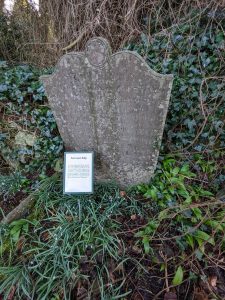 Back out in the churchyard, I wandered around admiring the snowdrops and making up stories in my head about some of the older graves. I wish more of them were legible. There are no neat paths laid out between the stones in this graveyard. It’s a little sad but also very beautiful compared to the neat rows of stones in a modern cemetery. As I was on a historic tour there was one more grave I wanted to see, also from my era but very different. Fortunately this one is well labelled now and the inscription very plainly copied.
Back out in the churchyard, I wandered around admiring the snowdrops and making up stories in my head about some of the older graves. I wish more of them were legible. There are no neat paths laid out between the stones in this graveyard. It’s a little sad but also very beautiful compared to the neat rows of stones in a modern cemetery. As I was on a historic tour there was one more grave I wanted to see, also from my era but very different. Fortunately this one is well labelled now and the inscription very plainly copied.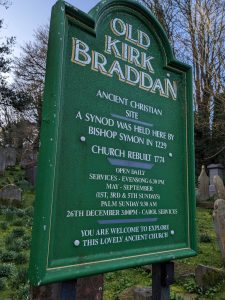 With time running out, I made my way back to the car, careful not to trip over a fallen gravestone in the tangle of grass and plants. I love ancient churches and graveyards and I’ve a feeling there are a few more I’ve not yet properly explored on the island so expect further posts. I especially love those which would have been here, an important part of island community life when my Manx sea captain and his wife first met in 1806 or returned to visit in 1811. Standing in these quiet places imagining those people gives me a very real sense of history.
With time running out, I made my way back to the car, careful not to trip over a fallen gravestone in the tangle of grass and plants. I love ancient churches and graveyards and I’ve a feeling there are a few more I’ve not yet properly explored on the island so expect further posts. I especially love those which would have been here, an important part of island community life when my Manx sea captain and his wife first met in 1806 or returned to visit in 1811. Standing in these quiet places imagining those people gives me a very real sense of history.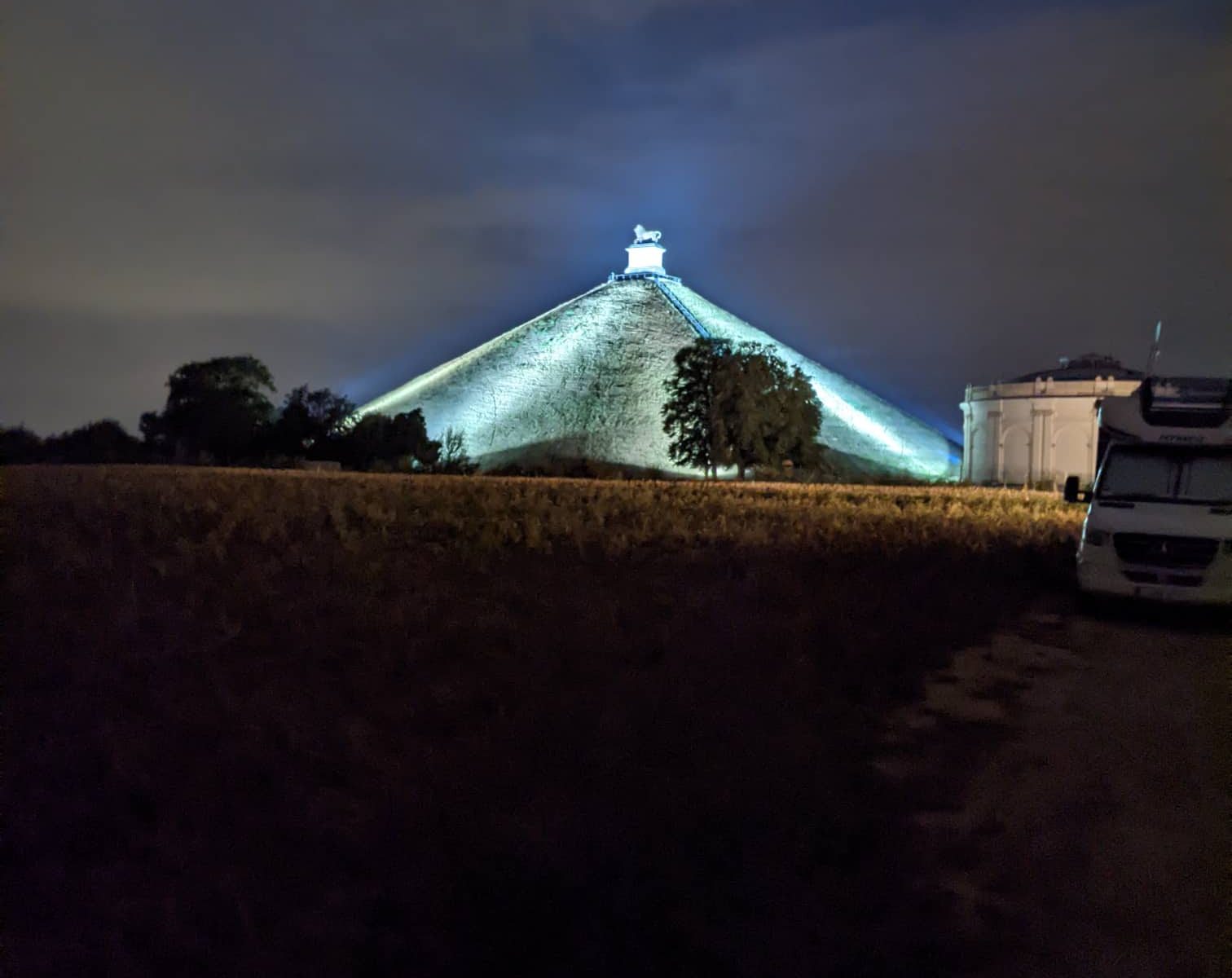
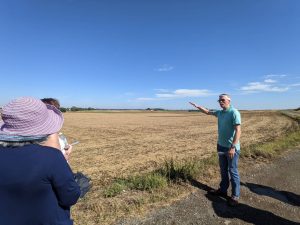
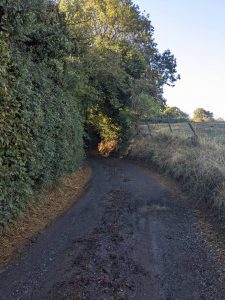 Number One London Tours
Number One London Tours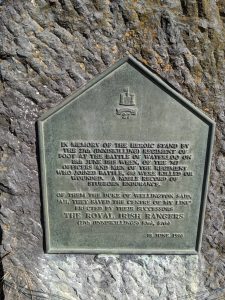 Features of the landscape like the covered way which is still partly visible, waist and head-high crops and surprisingly steep ridges help the story of the battle unfold far more easily than looking at maps. Gareth had maps a plenty though, to demonstrate each stage of the fighting as we reached it, starting from Papelotte and moving around the various parts of the field. He had also brought a copy of his fantastic
Features of the landscape like the covered way which is still partly visible, waist and head-high crops and surprisingly steep ridges help the story of the battle unfold far more easily than looking at maps. Gareth had maps a plenty though, to demonstrate each stage of the fighting as we reached it, starting from Papelotte and moving around the various parts of the field. He had also brought a copy of his fantastic Interspersed with clear, easy to understand descriptions of troop movements and the various attacks at different stages of the battle, were the individual stories from both Gareth and Kristine about the men who fought, suffered and died at Waterloo. I’ve seen many of these accounts before but hearing them read out on the ground where the action took place gave them a whole new meaning.
Interspersed with clear, easy to understand descriptions of troop movements and the various attacks at different stages of the battle, were the individual stories from both Gareth and Kristine about the men who fought, suffered and died at Waterloo. I’ve seen many of these accounts before but hearing them read out on the ground where the action took place gave them a whole new meaning.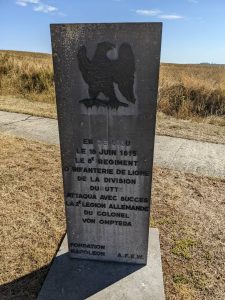 It was also horribly easy to imagine the aftermath, with dead and wounded strewn across the field. Injured men staggered towards anywhere they might find help and too many of them fell by the wayside. The memorials to the different armies and regiments as well as to a few individuals which are scattered around the battlefield highlight the poignant truth that most men who died at Waterloo had no marked grave, no memorial and quite possibly may not even have been buried at all.
It was also horribly easy to imagine the aftermath, with dead and wounded strewn across the field. Injured men staggered towards anywhere they might find help and too many of them fell by the wayside. The memorials to the different armies and regiments as well as to a few individuals which are scattered around the battlefield highlight the poignant truth that most men who died at Waterloo had no marked grave, no memorial and quite possibly may not even have been buried at all.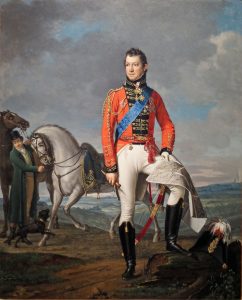
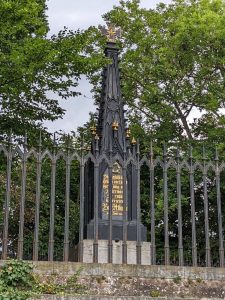
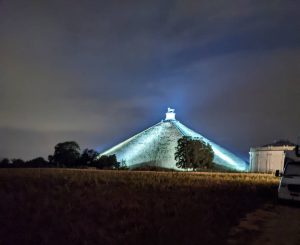 When we emerged, it was dark. Kristine had bought some flowers and a few of us walked up towards the Lion’s Mound which is lit up at night. It looked spectacular and despite all the jokes about it spoiling the battlefield, it felt like a fitting memorial that night, not to the Prince of Orange or Wellington or to any of the other individual commanders but to the thousands of anonymous men and animals who died on that field two hundred and seven years ago.
When we emerged, it was dark. Kristine had bought some flowers and a few of us walked up towards the Lion’s Mound which is lit up at night. It looked spectacular and despite all the jokes about it spoiling the battlefield, it felt like a fitting memorial that night, not to the Prince of Orange or Wellington or to any of the other individual commanders but to the thousands of anonymous men and animals who died on that field two hundred and seven years ago. 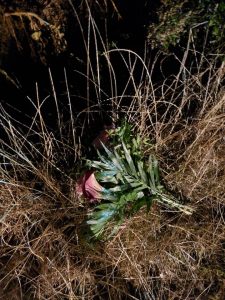 We placed the flowers on the edge of the field, not on any particular monument but just on a spot where any man might have fallen and stood quietly, listening on a phone to John Tams singing Spanish Ladies, a haunting folk song. A version of that song existed in 1815 and might have been sung by the campfires by men who did not survive that day. It seemed an appropriate memorial to the ordinary soldiers and the perfect way to end Waterloo 2022: the Battlefield Tour.
We placed the flowers on the edge of the field, not on any particular monument but just on a spot where any man might have fallen and stood quietly, listening on a phone to John Tams singing Spanish Ladies, a haunting folk song. A version of that song existed in 1815 and might have been sung by the campfires by men who did not survive that day. It seemed an appropriate memorial to the ordinary soldiers and the perfect way to end Waterloo 2022: the Battlefield Tour.
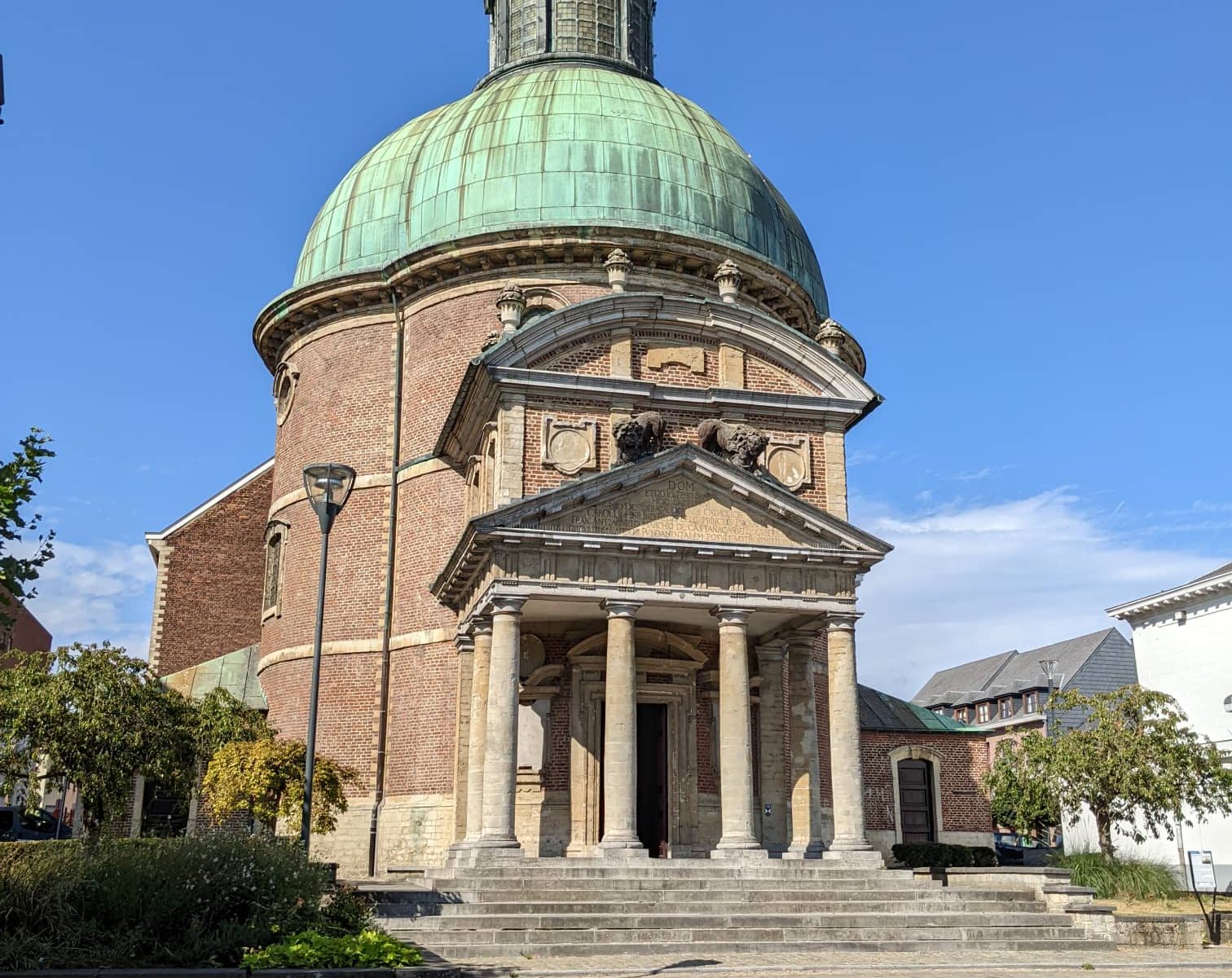
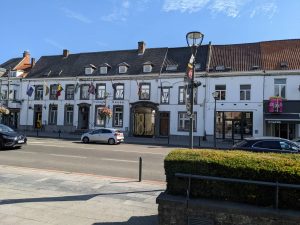
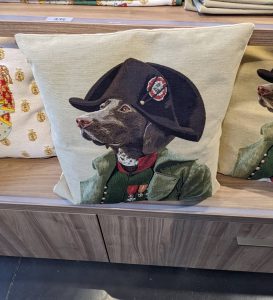 I have no idea whether there’s something political about this, whether it’s considered Napoleon was the most important person at Waterloo given that he was an Emperor or whether they just don’t think Wellington or Blucher memorabilia will sell. I do think it should probably be redressed, but if it’s a marketing decision then I guess that’s a good enough reason. All the same, Napoleon as a dog was a bit much for me.
I have no idea whether there’s something political about this, whether it’s considered Napoleon was the most important person at Waterloo given that he was an Emperor or whether they just don’t think Wellington or Blucher memorabilia will sell. I do think it should probably be redressed, but if it’s a marketing decision then I guess that’s a good enough reason. All the same, Napoleon as a dog was a bit much for me.
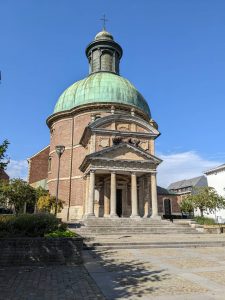 Across the busy road from the Wellington Museum is the elaborate church which was there at the time of the battle and used, like many churches, as a hospital to receive wounded men. Those of you who have followed me for a while know that I have a thing about old churches and this one was particularly peaceful, with a number of memorials to the men who fought and died during the Waterloo campaign. Memorials at this time tended to be paid for either by the family of the dead man or by subscription through the various battalions and regiments, so not surprisingly more of them relate to the wealthier regiments. Very few of the memorials even mention the NCOs and enlisted men apart from this one in the church, which may well be the first of its kind.
Across the busy road from the Wellington Museum is the elaborate church which was there at the time of the battle and used, like many churches, as a hospital to receive wounded men. Those of you who have followed me for a while know that I have a thing about old churches and this one was particularly peaceful, with a number of memorials to the men who fought and died during the Waterloo campaign. Memorials at this time tended to be paid for either by the family of the dead man or by subscription through the various battalions and regiments, so not surprisingly more of them relate to the wealthier regiments. Very few of the memorials even mention the NCOs and enlisted men apart from this one in the church, which may well be the first of its kind.
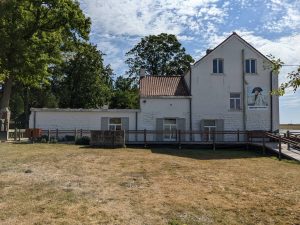 After lunch we moved on to Napoleon’s Headquarters in the farmhouse of Le Caillou, where Napoleon and his staff spent the night of June 17, 1815. The museum collection is spread over five rooms and tells the story of the Emperor’s actions in the hours before Waterloo. There are a number of artefacts relating to Napoleon, though Gareth queried whether some of the furniture was authentic given that the Prussians reputedly set fire to everything on their way through after Napoleon’s departure. Still, it gives a good sense of how the farm might have looked at the time.
After lunch we moved on to Napoleon’s Headquarters in the farmhouse of Le Caillou, where Napoleon and his staff spent the night of June 17, 1815. The museum collection is spread over five rooms and tells the story of the Emperor’s actions in the hours before Waterloo. There are a number of artefacts relating to Napoleon, though Gareth queried whether some of the furniture was authentic given that the Prussians reputedly set fire to everything on their way through after Napoleon’s departure. Still, it gives a good sense of how the farm might have looked at the time.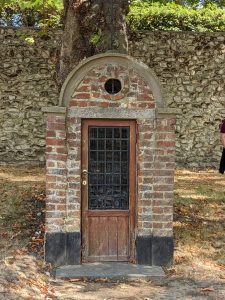 In the garden outside the farmhouse are one or two memorials. There is also an ossuary, which is a small building intended to serve as the final resting place of human bones. Ossuaries are often used where burial space is scarce but in this case it has become a depository for bones found on the battlefield over the years. I’ve seen photos of this but found the real thing unexpectedly moving.
In the garden outside the farmhouse are one or two memorials. There is also an ossuary, which is a small building intended to serve as the final resting place of human bones. Ossuaries are often used where burial space is scarce but in this case it has become a depository for bones found on the battlefield over the years. I’ve seen photos of this but found the real thing unexpectedly moving.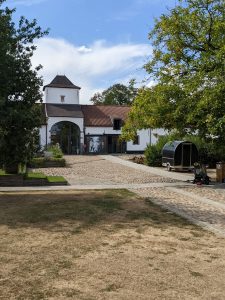
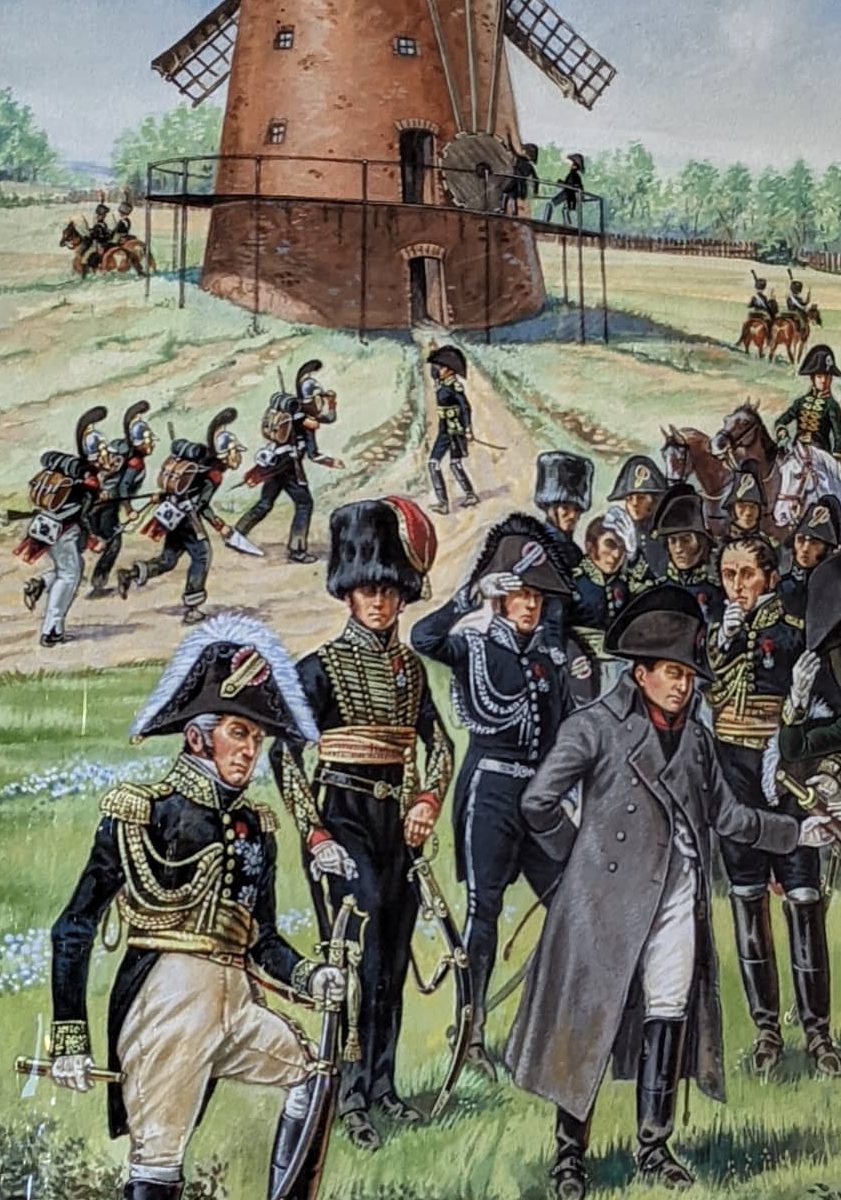

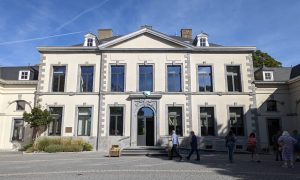
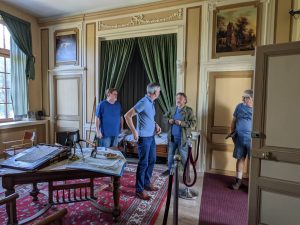
 Our next visit was to the small but very good museum in Ligny. It covers both Ligny and Quatre Bras and gave a very good sense of what happened on 16th June in these small villages and towns as the French inflicted a bloody defeat on Blucher’s Prussians and fought to a stalemate against Wellington’s Allied army. I was shocked at the extent of the casualties at both battles. Somehow I’d always had the vague impression that these were just skirmishes ahead of the main battle, but they clearly weren’t. All three armies were weakened by what happened on this day and it must have had an effect on what happened at Waterloo.
Our next visit was to the small but very good museum in Ligny. It covers both Ligny and Quatre Bras and gave a very good sense of what happened on 16th June in these small villages and towns as the French inflicted a bloody defeat on Blucher’s Prussians and fought to a stalemate against Wellington’s Allied army. I was shocked at the extent of the casualties at both battles. Somehow I’d always had the vague impression that these were just skirmishes ahead of the main battle, but they clearly weren’t. All three armies were weakened by what happened on this day and it must have had an effect on what happened at Waterloo.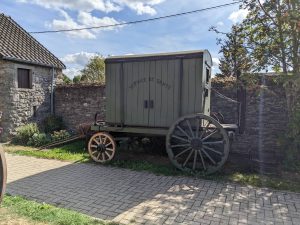
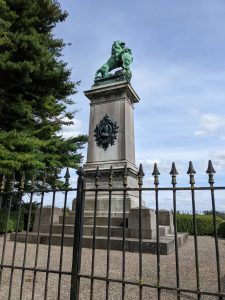
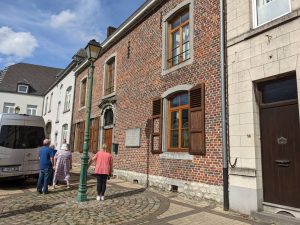
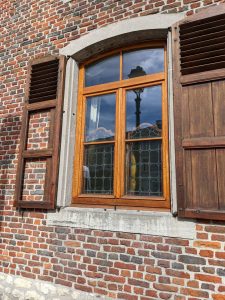
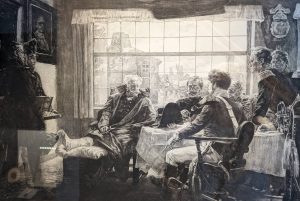
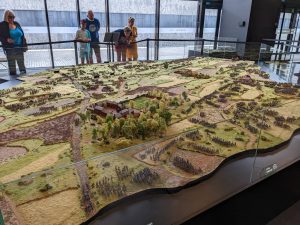 Waterloo 2022 – the Waterloo Museum and Hougoumont and we don’t hang about on the
Waterloo 2022 – the Waterloo Museum and Hougoumont and we don’t hang about on the 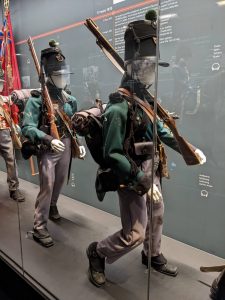 The museum gives an excellent overview of the history of the French revolution, Napoleon’s rise to power and the various coalitions and wars which led inexorably towards the Waterloo campaign. There are fabulous displays of weapons and uniforms from troops on both sides of the campaign, maps and models depicting the events of 1815 and the famous Waterloo Panorama which was painted in 1912 by Louis Dumoulin, and occupies a circular building. It is 110 metres in circumference and 12 metres high and the soundtrack plunges you into the midst of the battle. Despite, as Gareth assured us, a number of inaccuracies, it’s genuinely impressive and I’m glad we managed to see it before it closes for restoration later this month.
The museum gives an excellent overview of the history of the French revolution, Napoleon’s rise to power and the various coalitions and wars which led inexorably towards the Waterloo campaign. There are fabulous displays of weapons and uniforms from troops on both sides of the campaign, maps and models depicting the events of 1815 and the famous Waterloo Panorama which was painted in 1912 by Louis Dumoulin, and occupies a circular building. It is 110 metres in circumference and 12 metres high and the soundtrack plunges you into the midst of the battle. Despite, as Gareth assured us, a number of inaccuracies, it’s genuinely impressive and I’m glad we managed to see it before it closes for restoration later this month.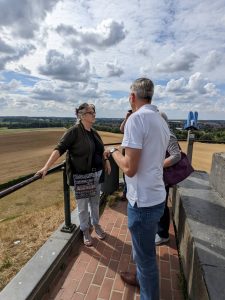
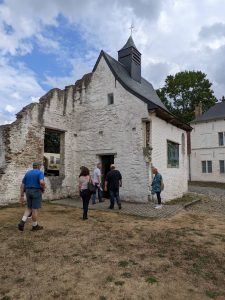
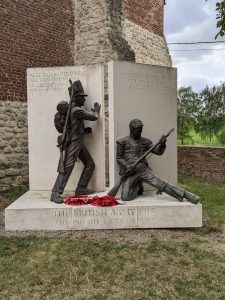
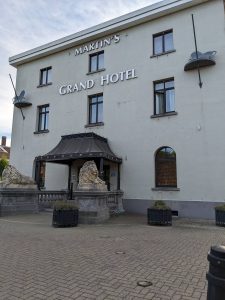
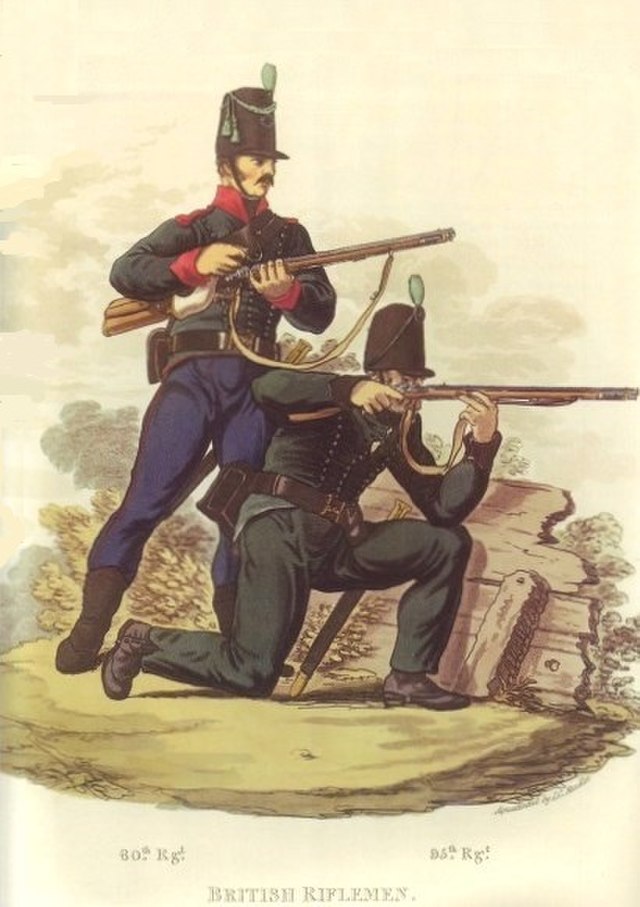
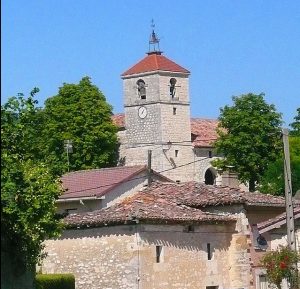
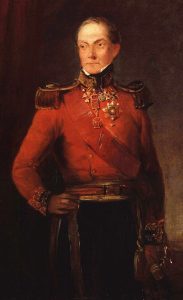
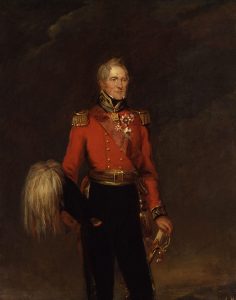
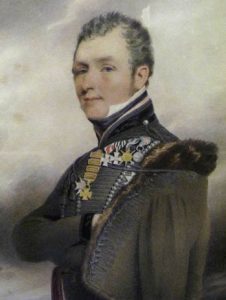
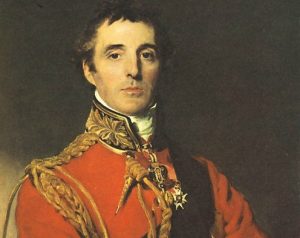 Despite Kincaid’s complaints, I actually think Moorsom sets out the roles of the various brigades and battalions very clearly; in fact I wonder if he may have adjusted a more biased account for a later edition because he seems to give full credit to all concerned in this excerpt. It also solves many of the problems of the previous accounts that I’ve mentioned above. It seems clear that General Alten did not send in his men quite so precipitately as suggested, and in fact waited until both his brigades had arrived on the hills above San Millan. That would give Lord Wellington time to make his appearance. It also sounds far more like the meticulous Alten to me.
Despite Kincaid’s complaints, I actually think Moorsom sets out the roles of the various brigades and battalions very clearly; in fact I wonder if he may have adjusted a more biased account for a later edition because he seems to give full credit to all concerned in this excerpt. It also solves many of the problems of the previous accounts that I’ve mentioned above. It seems clear that General Alten did not send in his men quite so precipitately as suggested, and in fact waited until both his brigades had arrived on the hills above San Millan. That would give Lord Wellington time to make his appearance. It also sounds far more like the meticulous Alten to me. 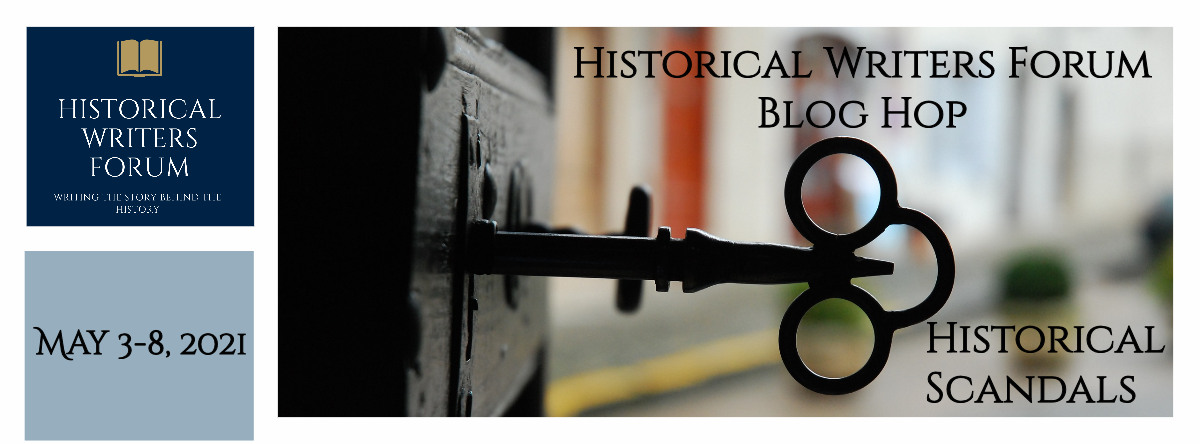
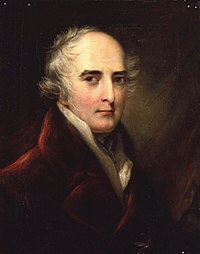 Richard Wellesley succeeded his father as Earl of Mornington but he did not make the traditional marriage expected of a Peer. Instead, he lived with a French actress called Hyacinthe-Gabrielle Roland. The couple had three sons and two daughters and Richard finally married her in 1794. Hyacinthe joined him in London, but the marriage was not a success. Hyacinthe was shunned by polite society because of her irregular union with Richard as well as her relatively humble origins. She never learned to speak English and was probably very lonely, and at some point during their marriage, the couple separated and lived apart.
Richard Wellesley succeeded his father as Earl of Mornington but he did not make the traditional marriage expected of a Peer. Instead, he lived with a French actress called Hyacinthe-Gabrielle Roland. The couple had three sons and two daughters and Richard finally married her in 1794. Hyacinthe joined him in London, but the marriage was not a success. Hyacinthe was shunned by polite society because of her irregular union with Richard as well as her relatively humble origins. She never learned to speak English and was probably very lonely, and at some point during their marriage, the couple separated and lived apart.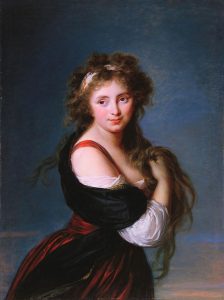
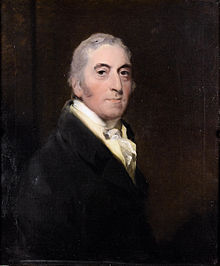 William was the second of the surviving Wellesley brothers and served in the Royal Navy. In 1781 he inherited the estates of his godfather, William Pole on the condition that he change his name. William later inherited the Earldom when his elder brother died with no legitimate son.
William was the second of the surviving Wellesley brothers and served in the Royal Navy. In 1781 he inherited the estates of his godfather, William Pole on the condition that he change his name. William later inherited the Earldom when his elder brother died with no legitimate son.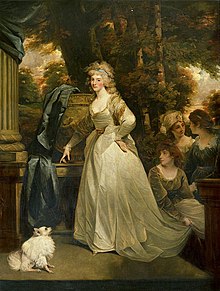
 Wellington was a young and impecunious officer when he met the Honourable Catherine ‘Kitty’ Pakenham in Dublin. The couple apparently fell in love, but her family rejected his proposal on the grounds that he was the third son of a large family with limited prospects. Wellington withdrew and became absorbed in an increasingly successful military career, while Kitty became engaged to Galbraith Lowry Cole, the second son of the Earl of Enniskillen.
Wellington was a young and impecunious officer when he met the Honourable Catherine ‘Kitty’ Pakenham in Dublin. The couple apparently fell in love, but her family rejected his proposal on the grounds that he was the third son of a large family with limited prospects. Wellington withdrew and became absorbed in an increasingly successful military career, while Kitty became engaged to Galbraith Lowry Cole, the second son of the Earl of Enniskillen.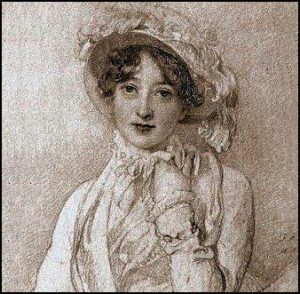 The marriage was not a success. Kitty tried hard to please her sharp-witted, decisive husband, but was unable to do so. They had little in common and very quickly began to live separate lives. Kitty doted on her sons and adopted children while Wellington pursued his career. He went to the Peninsula in 1808 and then again in 1809 and did not return until 1814. By then, the gap between them had widened still further. Kitty’s interests were all domestic; Wellington was a public figure.
The marriage was not a success. Kitty tried hard to please her sharp-witted, decisive husband, but was unable to do so. They had little in common and very quickly began to live separate lives. Kitty doted on her sons and adopted children while Wellington pursued his career. He went to the Peninsula in 1808 and then again in 1809 and did not return until 1814. By then, the gap between them had widened still further. Kitty’s interests were all domestic; Wellington was a public figure.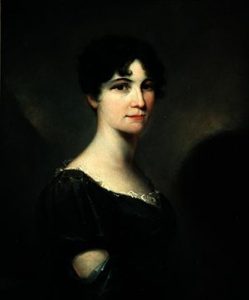 Mrs Harriet Arbuthnot was typical of this. Harriet was married to Charles Arbuthnot, a politician more than twenty years older than her, and was previously a close friend of Lord Castlereagh before he committed suicide in 1822. Harriet and Charles were Tories, and both became close to Wellington. Harriet and Wellington exchanged letters on a regular basis, and she frequently acted as his hostess and social secretary, particularly after Kitty’s death in 1831. Harriet was a diarist, and her observations have contributed greatly to our knowledge of Wellington as a man. Wellington was devastated at her early death of cholera in 1834. He and Charles Arbuthnot remained close, and Charles went to live with Wellington after Harriet’s death. There were undoubtedly rumours about Harriet’s relationship with Wellington, but these do not seem to have been taken seriously and very few people believe that they were anything more than close and devoted friends.
Mrs Harriet Arbuthnot was typical of this. Harriet was married to Charles Arbuthnot, a politician more than twenty years older than her, and was previously a close friend of Lord Castlereagh before he committed suicide in 1822. Harriet and Charles were Tories, and both became close to Wellington. Harriet and Wellington exchanged letters on a regular basis, and she frequently acted as his hostess and social secretary, particularly after Kitty’s death in 1831. Harriet was a diarist, and her observations have contributed greatly to our knowledge of Wellington as a man. Wellington was devastated at her early death of cholera in 1834. He and Charles Arbuthnot remained close, and Charles went to live with Wellington after Harriet’s death. There were undoubtedly rumours about Harriet’s relationship with Wellington, but these do not seem to have been taken seriously and very few people believe that they were anything more than close and devoted friends.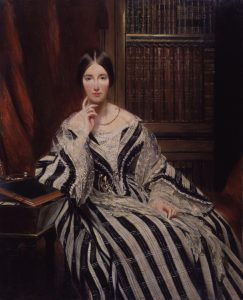
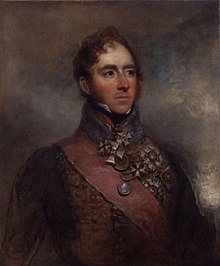
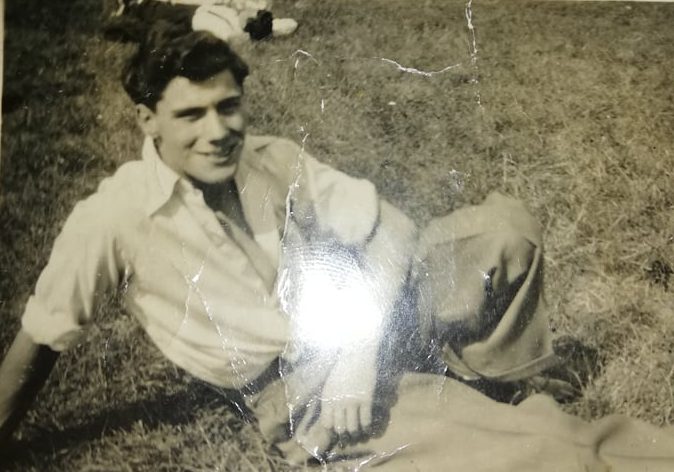
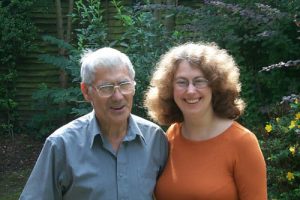
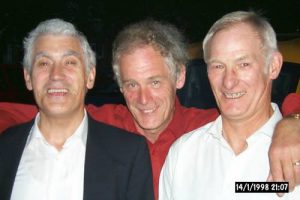
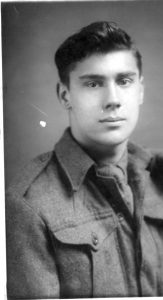
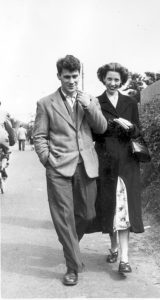
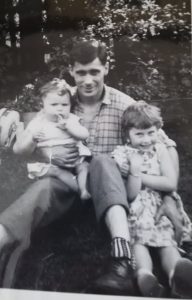
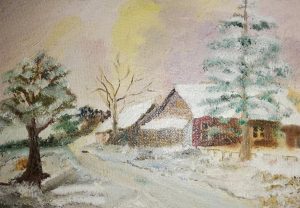 But there was more to Dad than just a father. He had interests and hobbies and for a shy man, he loved people. A self-taught but talented amateur artist, I can’t remember a time when he didn’t have a sketch book with him, and his paintings and drawings adorned our walls. He was very fit, a powerful swimmer, probably from his boyhood, growing up by the river, and a very good tennis player. I’ve never known where he learned that, but he used to play with my uncle every weekend through the summer.
But there was more to Dad than just a father. He had interests and hobbies and for a shy man, he loved people. A self-taught but talented amateur artist, I can’t remember a time when he didn’t have a sketch book with him, and his paintings and drawings adorned our walls. He was very fit, a powerful swimmer, probably from his boyhood, growing up by the river, and a very good tennis player. I’ve never known where he learned that, but he used to play with my uncle every weekend through the summer.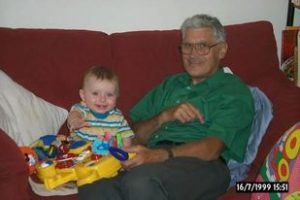

 I remember him as a quiet man, who tended to take a back seat in his very noisy family, but a man of principle, who would say what he wanted and wasn’t afraid to express a controversial opinion if he thought it was the right thing to do. A generous man, he would give both time and money to anybody in need. After his death, we received letters from all over the world, and discovered that for years he’d been an active member of a local International Club which was run through his church for overseas students and young people working in London, and he had friends in China, Indonesia and various parts of Africa who cared enough to write expressing their sorrow at his death. He was an animal lover, devoted to his various pets over the years, and supporting wildlife charities. And he was a family man, who loved his wife, his daughters and his grandchildren.
I remember him as a quiet man, who tended to take a back seat in his very noisy family, but a man of principle, who would say what he wanted and wasn’t afraid to express a controversial opinion if he thought it was the right thing to do. A generous man, he would give both time and money to anybody in need. After his death, we received letters from all over the world, and discovered that for years he’d been an active member of a local International Club which was run through his church for overseas students and young people working in London, and he had friends in China, Indonesia and various parts of Africa who cared enough to write expressing their sorrow at his death. He was an animal lover, devoted to his various pets over the years, and supporting wildlife charities. And he was a family man, who loved his wife, his daughters and his grandchildren.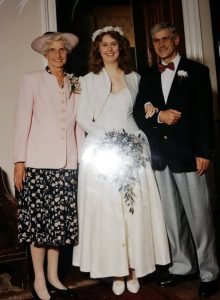 Happy ninety-first birthday Dad. I wish you’d lived long enough to hold my first published book in your hands, you’d have been so proud, but you read enough to know what I was writing and you loved it. You also had a lot to do with why I write what I do. Your life touched so many people, and they remember you as a good man. That’s not a bad epitaph.
Happy ninety-first birthday Dad. I wish you’d lived long enough to hold my first published book in your hands, you’d have been so proud, but you read enough to know what I was writing and you loved it. You also had a lot to do with why I write what I do. Your life touched so many people, and they remember you as a good man. That’s not a bad epitaph.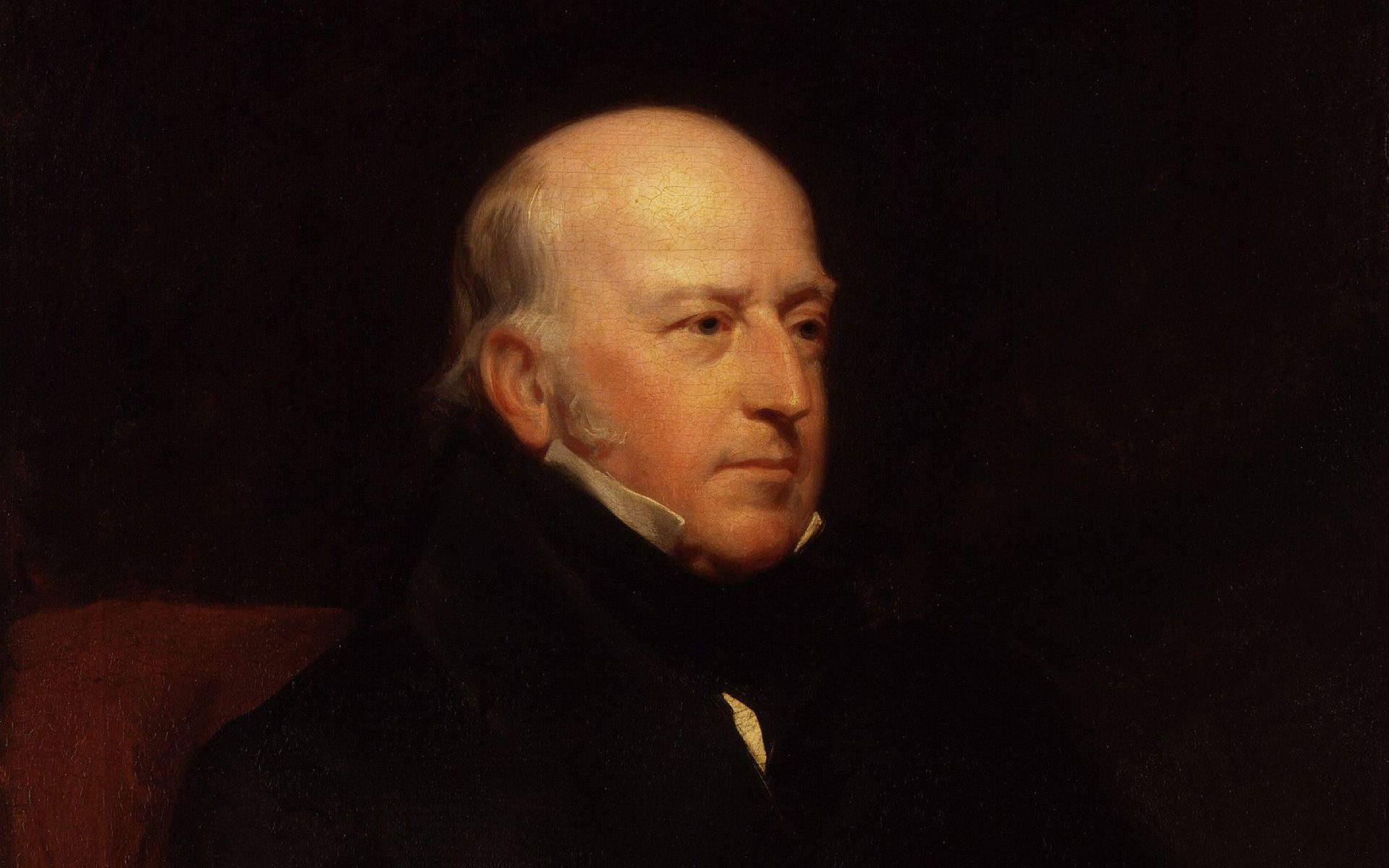
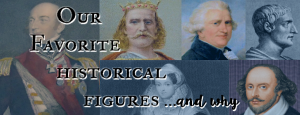 When I decided to write a post on Sir Edward Codrington for the latest
When I decided to write a post on Sir Edward Codrington for the latest 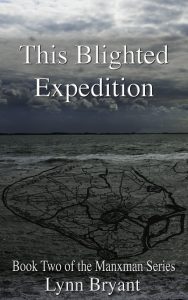 I introduced Codrington and his wife in
I introduced Codrington and his wife in 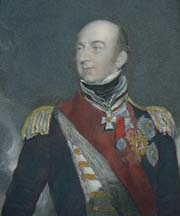 Edward Codrington was born in 1770, a youngest son in an aristocratic family. His mother died the same year, possibly giving birth to him, and his father died when he was five, leaving him to the care of an uncle by the name of Bethell. He was educated at Harrow for a short time and entered the Royal Navy in 1783 at the age of thirteen.
Edward Codrington was born in 1770, a youngest son in an aristocratic family. His mother died the same year, possibly giving birth to him, and his father died when he was five, leaving him to the care of an uncle by the name of Bethell. He was educated at Harrow for a short time and entered the Royal Navy in 1783 at the age of thirteen.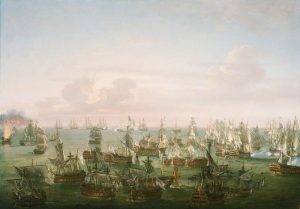
 In 1826, Codrington was appointed Commander-in-Chief of the Mediterranean Fleet and sailed for Greek waters in 1827, with orders to impose a peaceful solution on the chaos of the Greek War of Independence against the Ottoman Empire. Codrington was in command of a combined British, French and Russian fleet, and had been told to find a diplomatic solution. Diplomacy does not seem to have been Codrington’s strong point, and although he appears to have been under the mistaken impression that the Ottomans had broke an agreed truce, I suspect that the suffering of the local population would have been enough to set him off anyway. On 20 October 1827, in an action which very clearly exceeded his orders, Codrington destroyed the Turkish and Egyptian fleet at the Battle of Navarino.
In 1826, Codrington was appointed Commander-in-Chief of the Mediterranean Fleet and sailed for Greek waters in 1827, with orders to impose a peaceful solution on the chaos of the Greek War of Independence against the Ottoman Empire. Codrington was in command of a combined British, French and Russian fleet, and had been told to find a diplomatic solution. Diplomacy does not seem to have been Codrington’s strong point, and although he appears to have been under the mistaken impression that the Ottomans had broke an agreed truce, I suspect that the suffering of the local population would have been enough to set him off anyway. On 20 October 1827, in an action which very clearly exceeded his orders, Codrington destroyed the Turkish and Egyptian fleet at the Battle of Navarino. Codrington was buried in St Peter’s Church, Eaton Square, then in 1954, the remains were reburied at Brookwood Cemetery in Surrey. Plaques to his memory can be found in St Paul’s Cathedral and All Saints Church, Dodington, close to the family home and there is an obelisk dedicated to the memory of Codrington and his officers who fought at Navarino at Pylos, in Greece. Numerous roads are named after him in Greece, and stamps with his image have been issued.
Codrington was buried in St Peter’s Church, Eaton Square, then in 1954, the remains were reburied at Brookwood Cemetery in Surrey. Plaques to his memory can be found in St Paul’s Cathedral and All Saints Church, Dodington, close to the family home and there is an obelisk dedicated to the memory of Codrington and his officers who fought at Navarino at Pylos, in Greece. Numerous roads are named after him in Greece, and stamps with his image have been issued.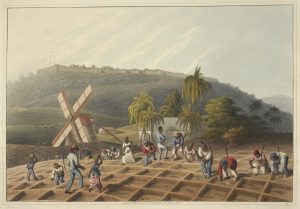 The book to which Codrington refers was “Examen de l’esclavage in général, et particulierement de l’esclavage des Nègres dans les colonies françaises de l’Amérique” which was published in 1802. I’ve not yet managed to read it, given that my French takes a while and a lot of patience, but as far as I am able to judge, it is written from an abolitionist standpoint. Britain was in the process of abolishing the slave trade, if not yet slavery itself, and it is interesting to see that Codrington was engaging with the debate in a way that suggests that he saw abolition as both desirable and inevitable. This was a very different standpoint to his brother, Christopher Bethell-Codrington, who in the same year rejected pressure from constituents to support the abolition of the slave trade, and continued to oppose abolition right to the bitter end.
The book to which Codrington refers was “Examen de l’esclavage in général, et particulierement de l’esclavage des Nègres dans les colonies françaises de l’Amérique” which was published in 1802. I’ve not yet managed to read it, given that my French takes a while and a lot of patience, but as far as I am able to judge, it is written from an abolitionist standpoint. Britain was in the process of abolishing the slave trade, if not yet slavery itself, and it is interesting to see that Codrington was engaging with the debate in a way that suggests that he saw abolition as both desirable and inevitable. This was a very different standpoint to his brother, Christopher Bethell-Codrington, who in the same year rejected pressure from constituents to support the abolition of the slave trade, and continued to oppose abolition right to the bitter end.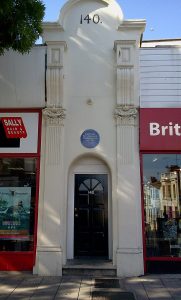 In 2009, the Greek Ambassador unveiled a blue plaque at the former home of Sir Edward Codrington in Brighton, and
In 2009, the Greek Ambassador unveiled a blue plaque at the former home of Sir Edward Codrington in Brighton, and 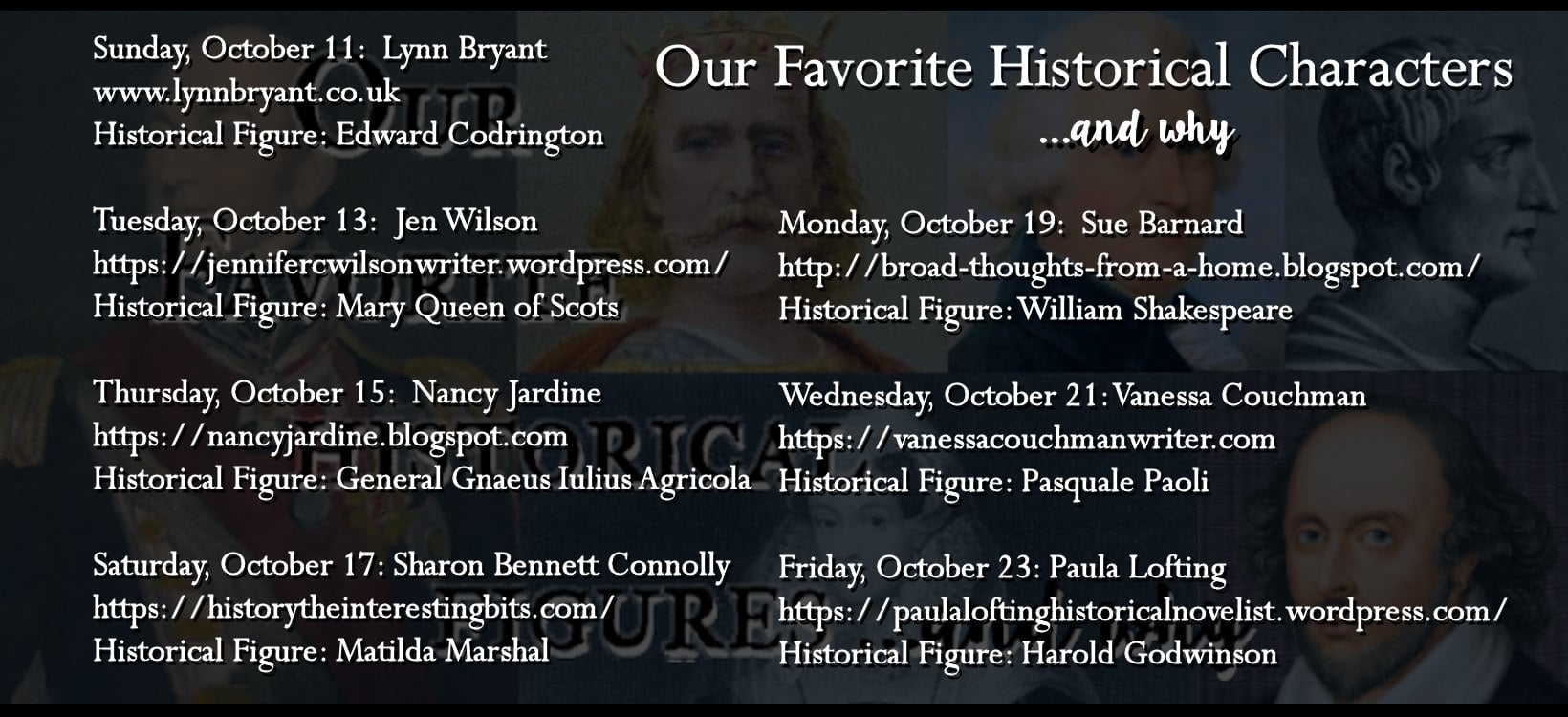
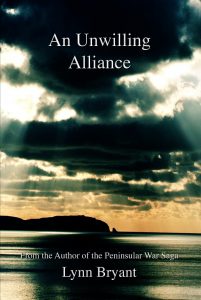 An Unwilling Alliance: the story of the Copenhagen campaign of 1807
An Unwilling Alliance: the story of the Copenhagen campaign of 1807